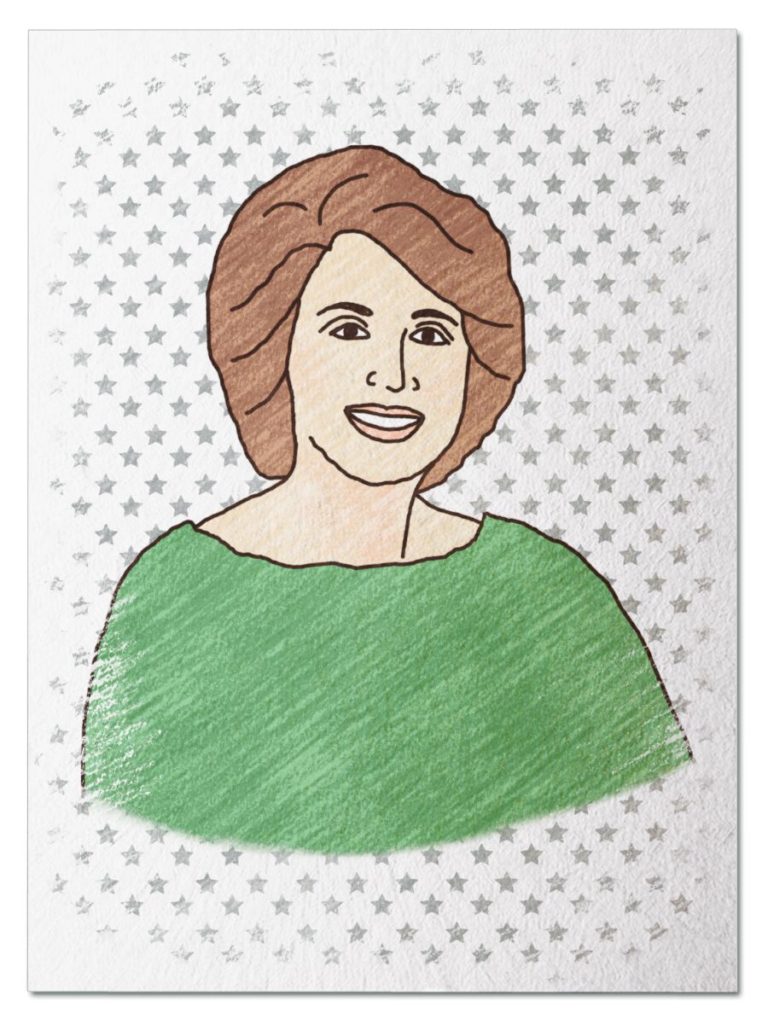
Exceptional Entertainer
She started her career as a three year old in a local park’s talent show and ended it as one of the most famous American opera singers in history. Along the way, she was a child radio star, toured the country with a traveling repertoire country, and didn’t let three years of rejection from the New York Opera Company discourage her. And once she finally got her invitation to join the NYOC, she dazzled the world with her voice and ability to disappear into some of opera’s most famous characters. She then set her sights on performing with the pinnacle of opera: the Metropolitan Opera Company. Walk on stage at Lincoln Center for her 1975 Met debut and meet Beverly Sills…
Her Ruby Shoe Moment
The Power of the Wand
Her Yellow Brick Road
Brains, Heart & Courage
Glinda’s Gallery
Just the Facts
Her Ruby Shoe Moment
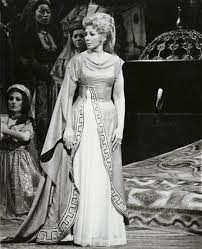
Beverly as Pamira in the Siege of Corinth (Metropolitan Opera)
Beverly Sills walked onto the stage at New York’s Lincoln Center. She was finally making her debut with the Metropolitan Opera Company, the pinnacle of opera in the United States. The production was The Siege of Corinth, her role was the lead, Pamira, and it was April 7, 1975. Beverly had been singing professionally since her teens, was a world famous soprano, and had performed in every other major opera house in the world. But the Met was different – special. Beverly had long believed her career wouldn’t be complete without it – it was the only major opera house in the world left for her to conquer. And it had been elusive for reasons that had nothing to do with her talent.
It was a personal grudge that had barred the door. The Met’s general manager was a traditional opera buff who believed in the superiority of his approach and of European sopranos. And years earlier, just a few days after he had staged a production that was a massive failure, Beverly had starred in a New York Opera Company production that received stellar reviews across the board. Because the NYOC was supposed to be the “second-tier” company in town, he held a grudge against Beverly for his embarrassment. It still took 3 years after his retirement for Beverly to be invited to join the Met onstage.
 And now, finally, at age 45, it was Beverly’s moment. Beverly faced the sold-out crowd of 4000 not as Beverly, but as Pamira, the daughter of the Governor of Corinth who must choose between her love for her country and for the leader of the invading Turks. But the audience was there for Beverly, and they lept to their feet to give her a two minute standing ovation.
And now, finally, at age 45, it was Beverly’s moment. Beverly faced the sold-out crowd of 4000 not as Beverly, but as Pamira, the daughter of the Governor of Corinth who must choose between her love for her country and for the leader of the invading Turks. But the audience was there for Beverly, and they lept to their feet to give her a two minute standing ovation.
Beverly was touched by her reception. While she had gotten comfortable with her reputation as the nation’s most famous opera singer, she had still been surprised by the publicity surrounding this appearance. The Met had raised ticket prices for the show and it still sold out immediately. There had been countdowns to this night in newspapers and television for months. But none of that prepared her for the excitement and energy she felt from the crowd as she savored the ovation.
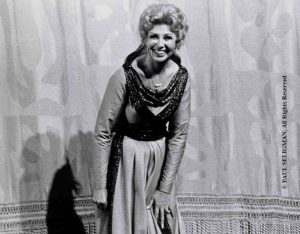
Beverly’s curtain call at her Met Debut in 1975 (Paul Seligman)
At times the atmosphere was more like a football game than an opera, with the crowd cheering and clapping at the end of each of Beverly’s arias. This came to a fever pitch in Act 2, when it was time for Beverly to sign the most difficult aria in the opera, Si ferite. After her last note faded into the air, the crowd again jumped to its feet, this time for almost 5 minutes. Beverly never broke character as she waited for the audience to finish, other than the tears in her eyes were her own. At the end, the audience gave her another standing ovation – this time for 18 minutes – with confetti raining down and flowers thrown at the stage!
Beverly’s performance had lived up to the hype. The New York Times reported that Beverly “made it as a diva should, with a brilliant new production, showstopping arias and the adoration of the multitude.” And her photo was on the front page of the New York Daily News the headline “Beverly Bows: Brava!” Beverly appeared in two additional shows at the Met over the next few years before she retired from singing professionally – Lucia in 1976 and Thaïs in 1978.
The Power of the Wand
Beverly Sills was an ambassador for opera in the United States – her talent opened doors for so many aspiring American divas – and her appearances on television and radio introduced operatic music to the masses. Today, America’s Got Talent has been a home for many young aspiring opera singers, like Victory Brinker and Lauren Bretan. Victory, a nine year old from Pennsylvania, finished in the top 10 of the 2021 season. Chicagoan Lauren placed 6th in the 2016 season when she was just 14.
Her Yellow Brick Road
Beverly began her professional singing career with the Gilbert & Sullivan national touring company, which traveled the country putting on musicals and operettas for local audiences. Her combination of strong voice and acting ability made her a featured lead performer, and the company began advertising her as “the youngest prima donna in captivity.”
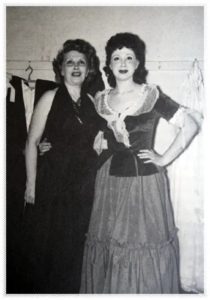
Beverly and her mom before a 1953 performance (BeverlySillsonline.com)
While Beverly appreciated the experience, her dream was to join an opera company in New York City, where she grew up. However, she struggled to get noticed in the opera realm. She spent her free time brainstorming ways to make herself more marketable. She had always had a strong memory, and put it to use to learn over 50 different opera roles by heart. She was thrilled when she finally got an offer from the Philadelphia Civic Opera to perform in its 1947 production of Bizet’s Carmen. Beverly wasn’t the lead but didn’t care. She eagerly took on a supporting role as the Spanish gypsy Frasquita and vowed to prove herself.
Unfortunately, tragedy struck not long afterward when Beverly’s father died suddenly in 1949. Her comfortable financial life came to an end and she had to put her opera dreams on hold to take better paying gigs. She sang in private clubs and then joined another national touring company. The company did produce some operas, and when she made her debut with them in San Francisco on September 15, 1953, her performance as Helen of Troy in the opera Mifist won rave reviews.
But Beverly held onto her dream of singing opera in New York. She returned closer home to perform whenever she could, including spending summers in the Catskills vacation area performing at the Concord Hotel. And every time the New York Opera Company held auditions, she was there. She spent three years auditioning for them and was rejected every time – until she wasn’t. Her perseverance paid off and they NYOC finally accepted her into the company in 1955.
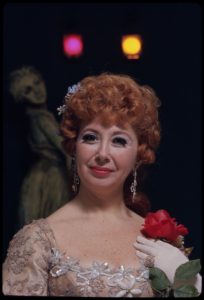
Beverly performing in Manon in 1969.
Beverly made her debut with the NYOC on October 29, 1955. She sang the role of Rosalinde in Johann Strauss’ Die Fledermaus. Critics and audiences alike wondered where Beverly had been hiding, raving about her voice, her acting talent, and her charisma.
From then on, Beverly had a busy schedule. She performed in 100 operas or concerts a year – averaging about one every three days! She kept added even more roles to her repertoire. Her voice was beautiful live, and also translated well onto film and vinyl. Her performances were taped and aired on television and recordings of her arias were played on record players nationwide.
Beverly had stepped away from the opera and her career after becoming a mom. Both of her children were born with disabilities. While she was at home navigating how to care for them, her good friend of hers, conductor Julius Rudel, spent his time trying to convince her to return to the stage. He finally succeeded, and in a few year’s time, she was the prima donna of the New York City Opera. Her experiences as a grieving mother brought new depth and sensitivity to her performances, and audiences noticed.
It was an exciting time, as opera was starting to reach a broader audience instead of just being reserved for the wealthy upper classes. Also, public investment in arts – including theaters and concert halls – was increasing. As part of this, the New York Opera Company moved into the Lincoln Center for the Performing Arts – in Fall 1966.
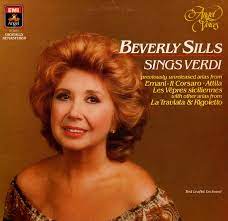
Beverly recorded several albums
Beverly’s star continued to rise. Part of Beverly’s appeal came from her willingness to tackle opera roles that were so difficult that they hadn’t been performed for years. She played three English queens on stage in Donizetti’s works: Queen Anne Boleyn in Anna Bolena, Queen Mary in Maria Stuarda, and Queen Elizabeth I in Roberto Devereux. She also starred as Cleopatra in Handel’s Julius Caesar, the Queen of the Night in Mozart’s Magic Flute.The Metropolitan Opera was the premiere company in New York and a much tougher nut to crack. Beverly did sing with them on as Donna Anna in Don Giovanni on July 9, 1966, but it wasn’t considered an official performance.
Beverly became very well-known in the United States, but as opera was born in Europe, in order to be a true diva, performing there was a must. And in 1967, she crossed the ocean as a guest of the Vienna State Opera. As her fame grew, she traveled around the world, performing all over Europe and South America. Her 1969 performance in La Scala in Milan, Italy became legendary.
Brains, Heart & Courage
Beverly’s dad immigrated to New York from Romania. He sold insurance for a living and wanted her to pursue a practical career too, like teaching. But her mom, also an immigrant (from the Ukraine), had other dreams for Beverly. When Beverly was 3, her mom entered her in the “Miss Beautiful Baby of 1932” competition at a local park. For the talent portion, she sang a song called “The Wedding of Jack & Jill.” Her voice won raves from the audience and first prize from the judges. By age 4, she was a regular voice on “Uncle Bob’s Rainbow House,” a Saturday morning children’s radio show.
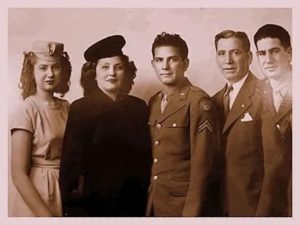
Beverly with her mom, dad, and brothers (BeverlySillsonline.com)
Beverly and her mom loved to go to shows. Beverly liked to watch how the singers moved their mouths to make their music, and wanted to do the same. She also loved to spend time with her huge Jewish family. She and her two older brothers spent most of their free time with their cousins. And there were a lot of them- their dad was one of 12 children and their mom one of 6.
Beverly’s mom loved opera and played Italian soprano Amelita Galli-Curci’s albums on her record player all the time. Beverly learned to love them too, and by the time she was 7, knew all 22 arias by heart. She started taking voice lessons from a woman named Estelle Liebling (was her teacher until Estelle died in 1970). She also took piano. When Beverly was 9, she became a regular performer on Major Bowes’ Amateur Hour, a radio show broadcast from the Capitol Theather in Manhattan. Every Sunday, Beverly and her mom made the trek there from their home in Brooklyn. She also got a paying gig singing Rinso White laundry detergent radio commercials, which earned her the nickname “Bubbles.”
Beverly wanted to just be a regular kid for awhile, so she left radio when she was 12. She went to local public schools and was a strong student, particularly in math. But performing called again, and she enrolled at Manhattan’s Professional Children’s School and continued memorizing operas. She knew nearly 60 of them by heart by the time she graduated.
Although her dad wanted her to go to college, when she was 16, she convinced him to let her tour with famous producer J. J. Shubert’s Gilbert and Sullivan repertory company.
Glinda’s Gallery
Just the Facts
- Beverly, a.k.a. Belle Miriam Silverman, was born on May 25, 1929 in Brooklyn, New York.
- Beverly married newspaper editor Peter Greenough in 1958. They initially lived in his hometown of Cleveland, where she encountered significant anti-semitism for the first time in her life. They eventually moved to Boston and then to New York.
- Beverly and Peter had two children. Their daughter was diagnosed with severe hearing loss when she was 2. Soon afterwards, their son was born with a devastating developmental disability. By the time he was 6 years old, he needed institutional around the clock care. Beverly wore two watches – one set on her time, and the other set to her son’s time zone so she knew what was happening in his daily schedule.
- Beverly donated her time, talent, and treasure to many organizations that helped kids with disabilities, including serving as national chairman of the March of Dimes Foundation (for which she helped raise $80 million!), and the Multiple Sclerosis Society.
- When Beverly was 50, she announced that she would soon retire from performing because she wanted to “put my voice to bed so it will go quietly, with pride,” The very next day – July 1, 1979, Beverly accepted the role of General Director of the New York City Opera Company, becoming the first woman and first singer to hold that position.
- Beverly ran the NYCO for 10 years. When she took the reins, the company was running a $5 million deficit. Beverly directed a wide variety of projects to reverse that trend, including producing new operas and modern versions of old favorites, English subtitles, sign language, hiring more American performers, programs for teens, and television appearances. By 1987, the NYCO was deficit free.
- Beverly gave her farewell performance at Lincoln Center on October 27, 1980, at age 51, The date chosen was the 25th anniversary of her first performance with the NY Opera. and was broadcast on PBS. 2000 fans attended and raised $1 million.
- Beverly won many awards in her lifetime, including the Handel Medallion (New York City’s highest cultural award 1973), Grammy Award (1976), Emmy Award (1975, 1977, 1980, 1981), and the Presidential Medal of Freedom in (1980).
- Beverly recorded 18 full-length operas. She won the highest musical honors in the United States (the Emmy) and Europe (the Edison). She also starred in 8 operas that aired on PBS.
- Beverly retired from her leadership role with the NY Opera in 1989. After five years out of the public eye, she became the first woman and first performer to chair the Lincoln Center of Performing Arts Board of Directors. In 2002, she moved on to serve as the Chair of the Metropolitan Opera. She stayed there until she retired completely from the arts world in 2005.
- Beverly was inducted into the into the Working Woman’s Hall of Fame in 1987, and the National Women’s Hall of Fame in 1988.
- In 2005, the Metropolitan Opera established the $50,000 Beverly Sills Artist Award for aspiring American singers
- Beverly died on July 2, 2007. She was 78.
Want to Know More?
Bender, William. “Sills Meets the Met” (Time Magazine Apr. 21, 1975).
Guy, Nancy. The Magic of Beverly Sills (Univ. of Illinois 2015).
Sills, Beverly. Bubbles: A Self Portrait (The Bobbs-Merrill Co. 1976).
Sills, Beverly. Bubbles: An Encore (Grosset & Dunlap, 1981).
Sochen, June. “Beverly Sills” (The Shalvi/Hyman Encyclopedia of Jewish Women).
Staff. “Beverly Sills Biography” (Encyclopedia of World Biography)
Staff. “Beverly Sills” (The Kennedy Center).
